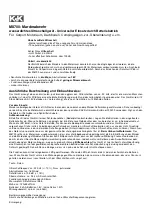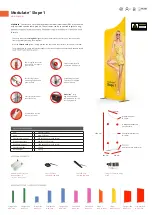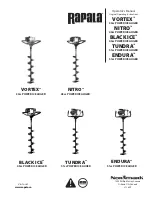
Section 2: Operating
1/19/21
RTR1550, RTR1558, RTR1566 & RTR1574 S/N- Rotary Tillers 311-431M
18
Operating Checklist
Hazard control and accident prevention are dependent
upon the awareness, concern, prudence, and proper
training involved in the operation, transport, storage, and
maintenance of the Rotary Tiller. Therefore, it is
absolutely essential that no one operates the Rotary
Tiller without first having read, fully understood, and
become totally familiar with the Operator’s Manual. Make
sure the operator has paid particular attention to:
•
Important Safety Information
, page 1
•
•
•
, page 22
•
Section 4: Maintenance & Lubrication
Inspections
Perform the following inspections before using your
Rotary Tillers.
Operating Checklist
Check
Page
Inspect tractor safety equipment to make sure it
is in good working condition.
Tractor
Manual
Check all guards and shields to make certain they are
in good working condition, in place, and secured.
Tractor
Manual
Carefully raise and lower implement to ensure
drawbar, tires, and other tractor parts do not contact
tiller
frame or driveline.
Tractor
Manual
Check driveline to be sure it is securely connected at
both ends. Refer to “Driveline Installation”.
Check drive chain tension.
Refer to “Drive Chain Tension”.
Check
tiller
depth setting.
Refer to “Skid Shoe Adjustment”.
Check driveline slip clutch to make sure disks will slip.
Refer to “Driveline Protection”
Check for worn, bent, broken, loose, and/or missing
tines
. Replace
tines
as needed.
Refer to “Tine Replacement”
Grease driveline shaft and all other grease fittings
Refer to “
Driveline Shaft
”.
Check oil level in gearbox. Make sure all plugs have
been replaced when completed.
Refer to “Gearbox Lubrication”.
Check oil level in chaincase. Make sure all plugs have
been replaced when completed.
Refer to “Chaincase Lubrication”.
Check
tiller
initially and periodically for loose bolts
and pins. Refer to “Torque Values Chart”.
Safety Information
DANGER
!
To avoid serious injury or death:
•
Do not engage power take-off while hooking-up or
unhooking the driveline, or while someone is standing near
the driveline. A person’s body and/or clothing can become
•
Make certain driveline yokes are securely fastened at each
end. A loose yoke can work free allowing the driveline to
rotate uncontrollably causing implement damage and
bodily injury or death to anyone nearby.
•
Keep away from rotating hex drive shaft located between
gearbox and drive end of tiller. A person can become
•
Do not use a power take-off adapter with a quick hitch. The
adapter will increase strain on the tractor’s power take-off
shaft causing possible damage to shaft and driveline. It will
also defeat the purpose of the tractor’s power take-off
•
Keep front rubber dirt deflector on reverse tine tillers in
place while operating the unit. Objects in a reverse tine
tiller can be thrown forward toward the operator.
•
Keep yourself and all others away from rotating tines and
drive train. Always disengage power take-off and lockout
power source before making adjustments or servicing the
tiller. A person’s body, hair, or clothing can become
entangled in rotating components causing serious bodily
•
Make all 3-point hydraulic adjustments from the tractor
seat. Never make hydraulic adjustments while standing
•
Never make contact with underground utilities such as
electrical power lines, gas lines, phone lines, etc. They can
cause serious injury or death from electrocution, explosion,
or fire. Always call 811 (USA) before digging so that they
can mark the location of underground services in the area.
For contact information, see Dig Safe in the “Important
Safety Information” starting on page 1.
•
Tractor power take-off shaft shield, driveline shields, and
gearbox shaft shields must be installed and in good working
condition to avoid driveline entanglement and projectiles
•
Tine impact on objects can throw projectiles resulting in
bodily injury or death. Do not point discharge toward
people, animals, or buildings and keep people and animals
away from tiller during operation.
Section 2:
Operating
Page 27
















































